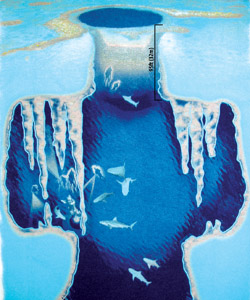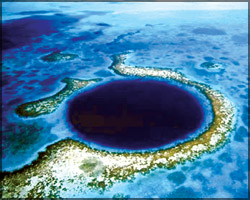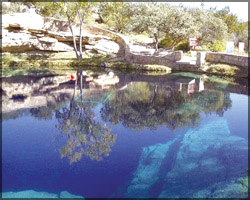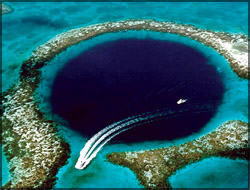Blue holes in the ocean?
Continued from last week
Blue holes which are considered to be virtually ‘bottomless pits’
have no defined boundaries as such and cover huge areas. Offering a
fascinating view of the ancient subterranean(underground) world, they
often give divers a glimpse of marine species rarely seen elsewhere in
the world.
|

An artist’s impression of the inside of a blue hole |
Many of these unique subterranean caves where scientists can travel
back in time have been discovered during the past 30 years. The water in
these blue holes are said to be motionless; water does not circulate as
freely as in most other places.
The temperature of the water at depths of about 130 ft is said to be
about 76 degrees Fahrenheit. Hardly any changes are seen throughout the
year. The walls are steep until a depth of 110 ft and then divers
encounter beautiful stalactite formations (lime deposits like icicles on
roofs of caves).
|

Blue Hole of Dahab,Egypt |
Very little light is known to reach the depths of these blue holes
where the awesome ecosystems of about millions of years could be seen.
Once past 60 ft, not much corals can be seen in some blue holes,
according to divers.
From the incredible geological formations to the unique marine life,
blue holes of the ocean or inland, offer the best diving experience in
the world, say most professional divers.
Some of the blue holes which are popular diving sites or tourist
attractions are:
The Blue Hole of Ohio
It was a popular diving site in the past. It is located five miles
southwest of Sandusky in Castalia and is the only blue hole which was
once open to the public even though seven more blue holes are located in
the area.
|

Blue Hole of Santa Rosa |
The water is said to contain lime, soda, magnesia and iron. The
temperature stands constant and is around 48 degrees Fahrenheit. So far
no one has been able to locate the bottom of this blue hole though many
have dived into it in the past.
The Blue Hole of Dahab,South Sinai, Egypt
This particular blue hole is nicknamed the Diver’s cemetery because
many divers have lost their lives attempting to explore it. It is said
to have fascinating coral lagoons which open to the Red Sea through a
tunnel known as the Arch.
Dean’s Blue Hole, Bahamas
Located about one kilometre from Clarencetown on the north Atlantic
side of Long Island, Bahamas, it is the world’s deepest blue hole.
Devil’s Hole, Bermuda
This blue hole, located in a popular tourist area, is said to contain
more than 400 species of marine life. It’s not as deep as most other
blue holes.
The Blue Hole of Santa Rosa, New Mexico
The diameter of the surface is around 80 feet, but it increases to
around 130ft or more further down. The depth is over 80ft.
Facts:
Three types of blue holes in the Bahamas have been distinguished.
|

Great Blue Hole
of Belize |
Ceynotes - Vertical shafts about 50 to 150 m in diameter which extend
to 50 to 100m depths.
Lens-based caves - Extensive system formed at the contact zone
between fresh and marine ground waters.
Fracture-guided caves - Vertical, linear systems developed on major
fractures running parallel to the steep edge of the carbonate bank.
Frequently reach depths of 100m or more.
There are many such blue holes in various parts of the world. Try to
read more on these naturally occurring deep holes on sea and land and
enhance your knowledge about the wonders of the world.
Facts and pix: Internet |
